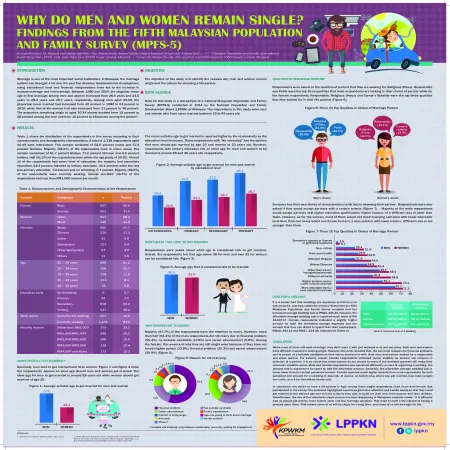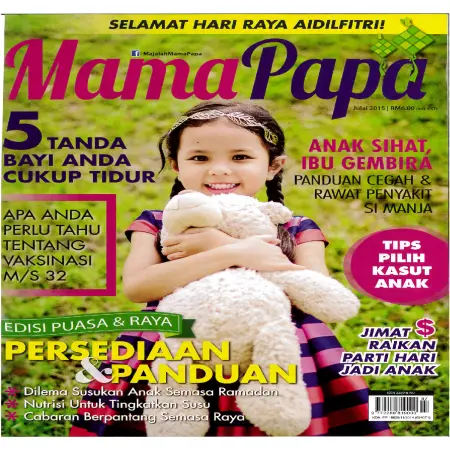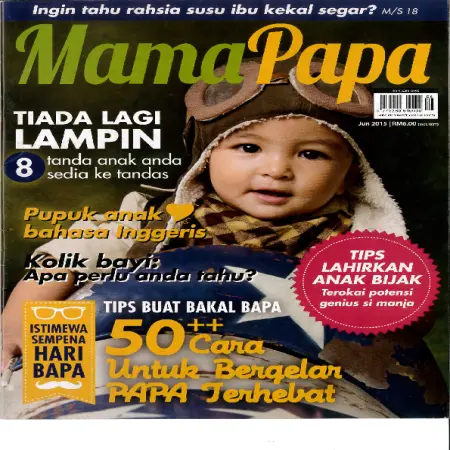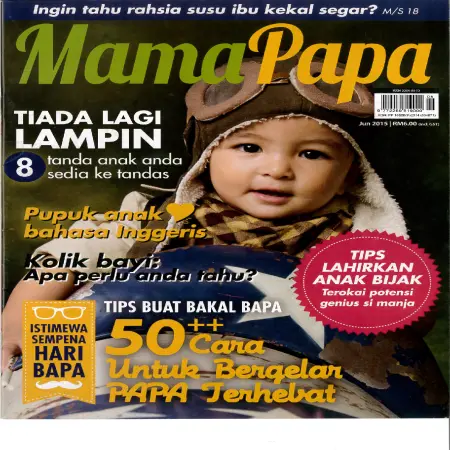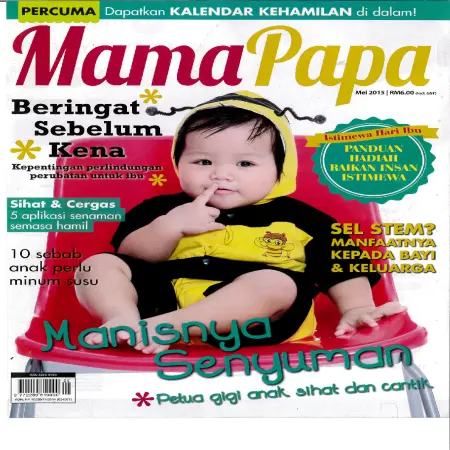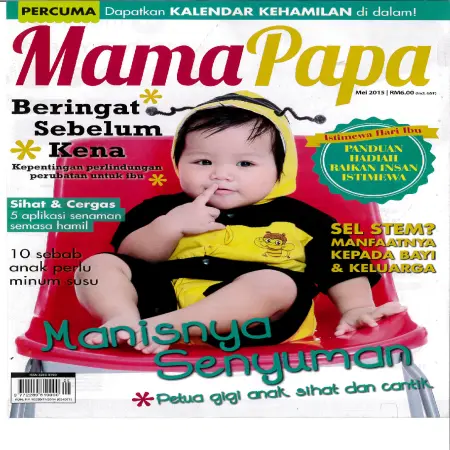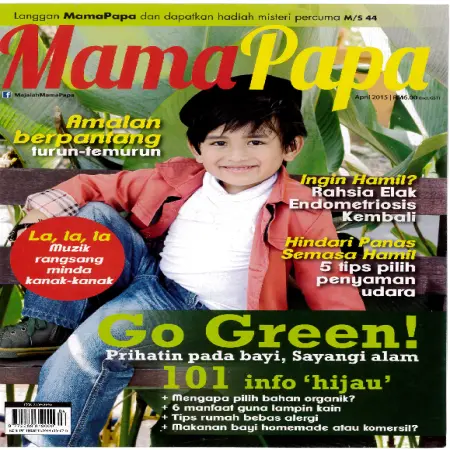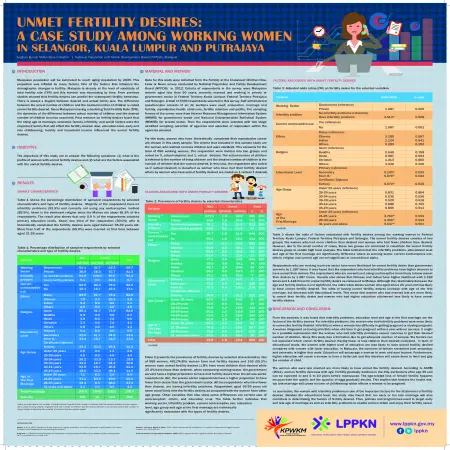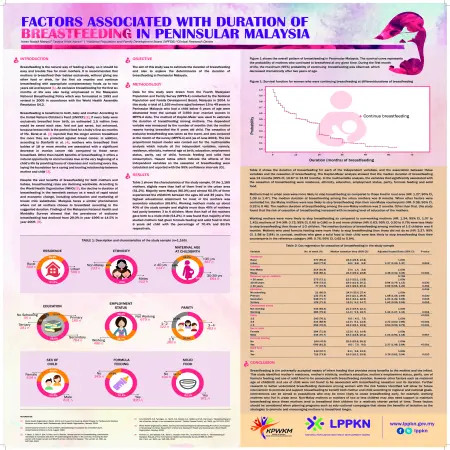Browse by Year
|
|
Why do men and women remain single? Findings from the Fifth Malaysian Population and Family Survey (MPFS-5)
Item Type: Scientific Poster
Editor:
Year: 01/07/2015
Abstract: Marriage is one of the most important social institutions. In Malaysia, the marriage pattern has changed a lot over the past few decades. Socioeconomic development, rising educational level and financial independence have led to the increase in delayed marriage and non-marriage. Between 1980 and 2010, the singulate mean age at first marriage among men and women increased from 26.6 years and 23.5 years to 28.0 years and 25.7 years, respectively. Among men aged 25-29, the proportion never married had increased from 40 percent in 1980 to 53 percent in 2010, while that of the women had also increased from 21 percent to 38 percent. The proportion remaining single at aged 30-34 almost doubled from 15 percent to 28 percent among the men and from 10 percent to 18 percent among the women. The objective of this study is to identify the reasons why men and women remain single and the criteria for choosing a life partner.
|
|
|
|
|
|
Yang mana satu pilihan: keluarga kecil atau besar
Item Type: Article
Editor:
Year: 10/07/2015
Abstract: In the current of modernization, many couples are planning to limit the number of their family members. Among the factors that push them to plan a family are getting married at a late age and the rising cost of living. The practice of family planning is very helpful in determining the birth distance between children and the size of the appropriate number of children for a family. This contraceptive practice can also prevent pregnancy in high-risk women, i.e. women with serious health problems or hereditary diseases.
|
|
|
|
|
|
10 tips luangkan masa berkualiti bersama keluarga
Item Type: Article
Editor:
Year: 03/06/2015
Abstract: Quality time with family is when family members can spend time with mutual benefits. The time is filled with activities or interactions that can further strengthen the relationship between family members. This article shares about 10 tips to spend quality time with family such as, praying together, eating, tidying and cleaning the house together, studying children's lessons, shopping, doing leisure activities together, traveling, family reunions, doing hobbies together, and corner mini library.
|
|
|
|
|
|
Toleh kiri dan toleh kanan
Item Type: Article
Editor:
Year: 00/06/2015
Abstract: The aspect of safety in the family needs to be educated and made a daily practice and needs to be educated with patience without despair. There are some simple tips to practice in family safety such as don’t stop praying, keep dangerous and important equipment in a special place, safe zone to explore and consensus brings blessings.
|
|
|
|
|
|
Imbangi keluarga dan kerjaya
Item Type: Article
Editor:
Year: 00/05/2015
Abstract: Based on the Fourth Malaysian Population and Family Survey (MPFS-4), it was found that overall, mothers do more leisure activities with their children, especially children under seven years old. This study found that the percentage of parents who often spend special time with their children is higher among mothers (80.2%) than fathers (65.3%). However, the percentage of those who frequently took their children on outings was almost the same between mothers (52.2%) and fathers (52.4%).
|
|
|
|
|
|
Apa wanita perlu tahu: subur@tidak subur?
Item Type: Article
Editor:
Year: 00/05/2015
Abstract: Fertility is the ability to conceive naturally. As a measure, fertility rate is the number of children born per individual, household or population. Fertility varies according to fertility, i.e. the potential to reproduce (which is influenced by gamete production, fertilization and the ability to conceive long enough). There are several types of ovulation disorders that are 35% of the cause of infertility in women, namely anovulation. Anovulation is a condition where no ovulation process occurs or the egg process is released from the ovaries, oligovulation is an irregular ovulation process that sometimes occurs, sometimes not and the anovulation cycle is a menstrual cycle in which no ovulation process occurs at the cycle.
|
|
|
|
|
|
Selamatkah mainan anak anda?
Item Type: Article
Editor:
Year: 00/04/2015
Abstract: Children's toy can help the educational and developmental process of children at an early age. However, the selection of children's toys needs to be done wisely especially if it involves safety aspects. If parents do not carefully choose toys, it can invite danger to the safety of children. To ensure the safety of children and prevent accidents or unwanted incidents, some things that need to be considered include choosing toys according to the level of age suitability of children, toys not made of toxic materials, avoid toys that contain magnetic materials or batteries to little children and toys that have noise.
|
|
|
|
|
|
Portrait of 1Malaysia Family First (1MFF)
Item Type: Book
Editor:
Year: 00/01/2015
Abstract: The 1MFF movement is a national agenda to increase commitment and invite all levels of society to return to giving priority to the family institution in all efforts, planning and actions. It is hoped that the 1Malaysia Family First (1MFF) element will create a lasting bond of love in family and community institutions. The initiatives introduced under the 1MFF Movement are implemented based on the 3 thrusts outlined in the National Family Policy, namely to increase the commitment and social responsibility of all parties in implementing family -friendly policies and programs; review and ensure existing laws, policies and regulations prioritize the family perspective; and provide family services and facilities that are easily accessible and accessible to families.
|
|
|
|
|
|
Unmet fertility desires: a case study among working women in Selangor, Kuala Lumpur and Putrajaya
Item Type: Scientific Poster
Editor:
Year: 00/00/2015
Abstract: Malaysia population will be estimated to reach aging population by 2035. This projection was inflated by many factors. One of the factors that influence the demographic changes is fertility. Malaysia is already at the level of substitute of total fertility rate (TFR) and this number was decreasing by time. From previous studies showed that fertility desires can predict the subsequent fertility behavior. There is always a disjoint between desired and actual family size. The difference between the actual number of children and the desired number of children is called unmet fertility desired. Since Malaysia is having a declining Total Fertility Rate (TFR), the dynamics of the difference between actual number of children and the desired number of children must be examined. Past research on fertility desires found that the rising age at marriage, economic factors, infertility, and social factors were the important factors that will affect the fertility desired. Also, education level, early and late childbearing, locality and household income influenced the unmet fertility desires.
|
|
|
|
|
|
Factors associated with duration of breastfeeding in Peninsular Malaysia
Item Type: Scientific Poster
Editor:
Year: 00/00/2015
Abstract: Breastfeeding is the natural way of feeding a baby, so it should be easy and trouble free for most mothers. It is recommended that mothers to breastfeed their babies exclusively, without giving any other food or drink, for the first six months and continue breastfeeding with appropriate complementary foods up to two years old and beyond [1]. An exclusive breastfeeding for the first six months of life was also being emphasized in the Malaysian National Breastfeeding Policy which was formulated in 1993 and revised in 2005 in accordance with the World Health Assembly Resolution 54.2. Breastfeeding is beneficial to both, baby and mother. According to the United Nations Children’s Fund (UNICEF) [2], if every baby were exclusively breastfed from birth, an estimated 1.5 million lives would be saved each year. And not just saved, but enhanced, because breast milk is the perfect food for a baby’s first six months of life. Beral et al. [3] reported that the longer women breastfeed the more they are protected against breast cancer. In addition, according to Danforth et al. [4], mothers who breastfeed their babies of 18 or more months are associated with a significant decrease in ovarian cancer risk compared to those never breastfeed. Other than health benefits of breastfeeding, it offers a natural opportunity to communicate love at the very beginning of a child’s life by providing hours of closeness and nurturing every day, laying the foundation for a caring and trusting relationship between mother and child [2]. Despite the vast benefits of breastfeeding for both mothers and babies, breastfeeding rates are declining worldwide. According to the World Health Organization (WHO) [5], the decline in duration of breastfeeding in the twentieth century as a result of rapid social and economic change, including urbanization and marketing of breast milk substitutes. Malaysia faces a similar phenomenon where not all mothers choose to breastfeed according to the suggested duration. Findings of the Malaysian National Health and Morbidity Surveys showed that the prevalence of exclusive breastfeeding had declined from 29.0 % in year 1996 to 14.5 % in year 2006 [6]. Objective: The aim of this study was to estimate the duration of breastfeeding and also to explore the determinants of the duration of breastfeeding in Peninsular Malaysia.
|
|
|
|





